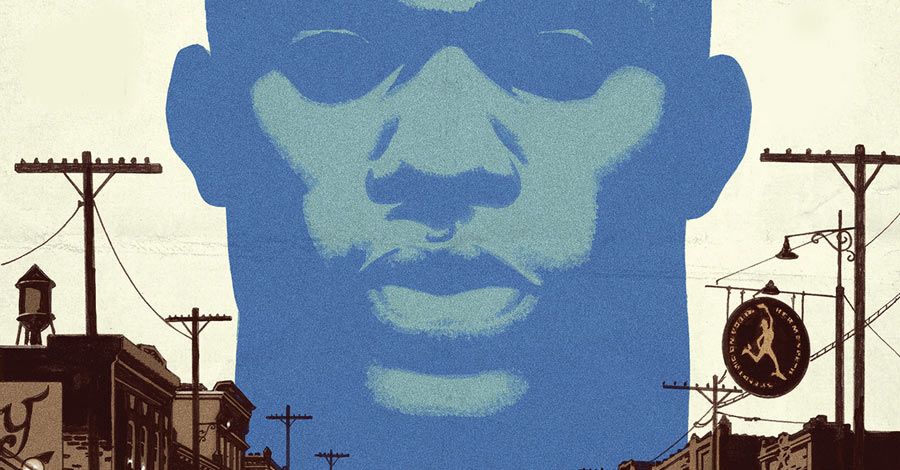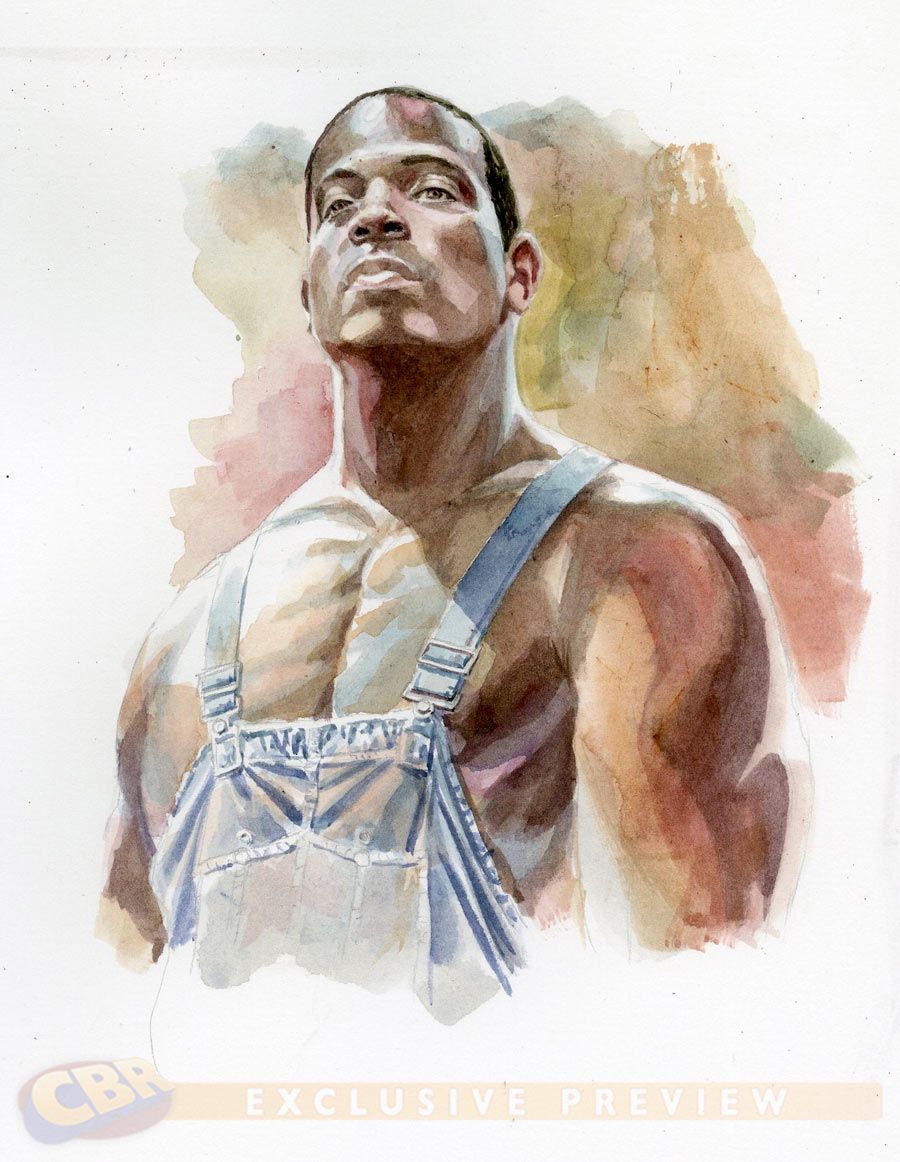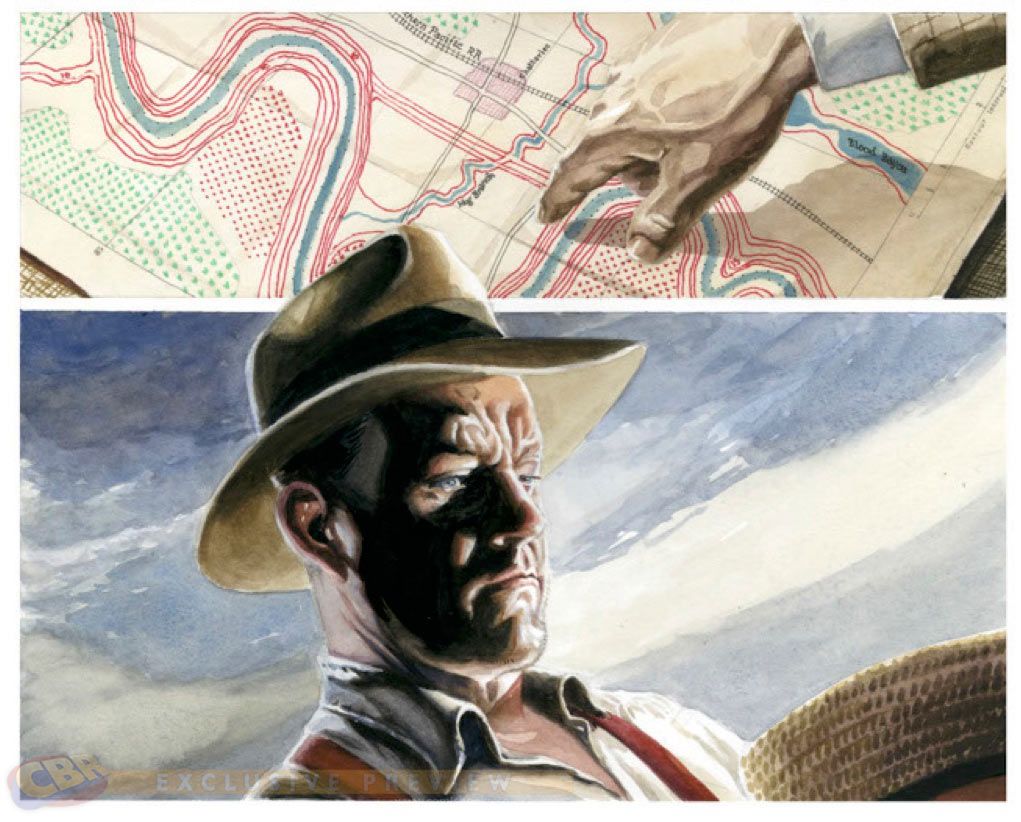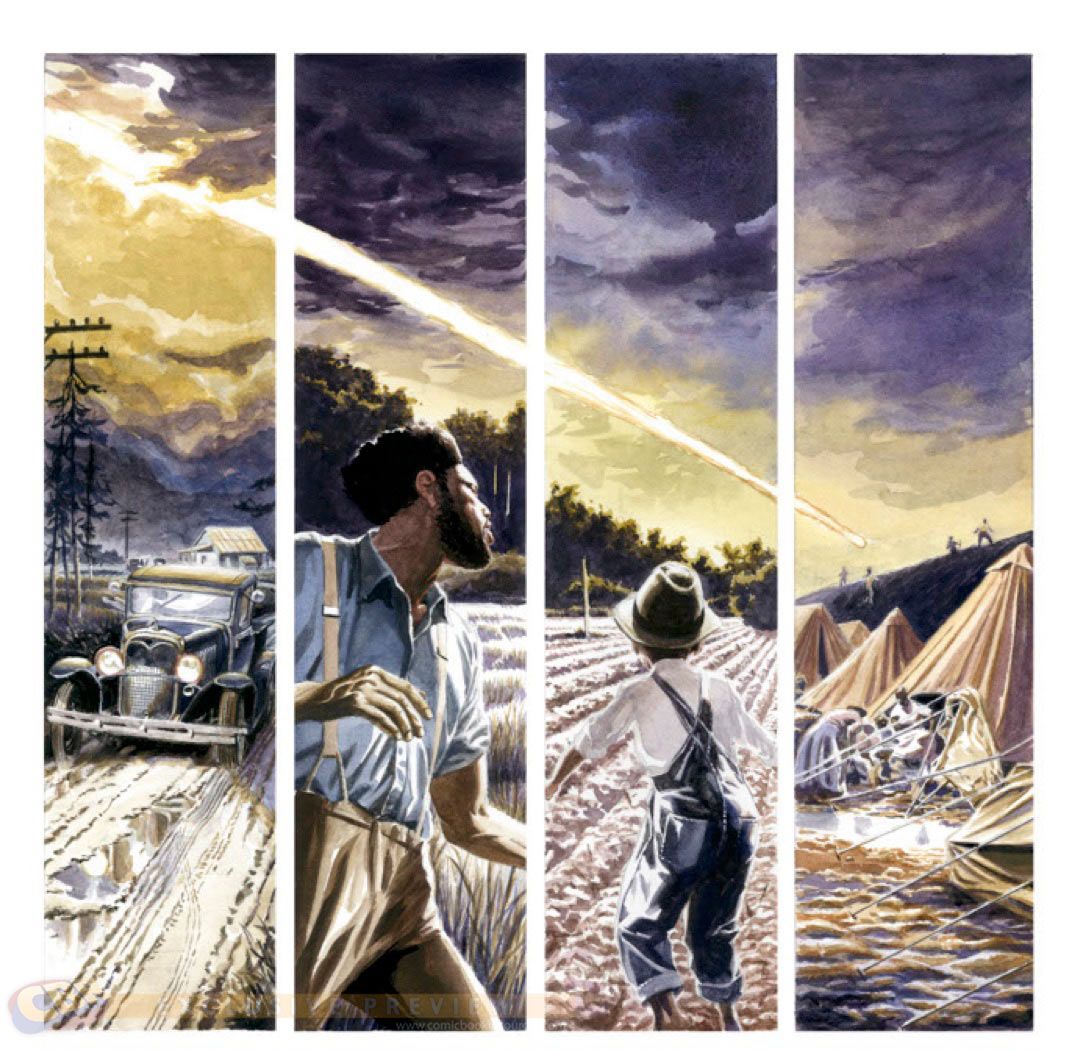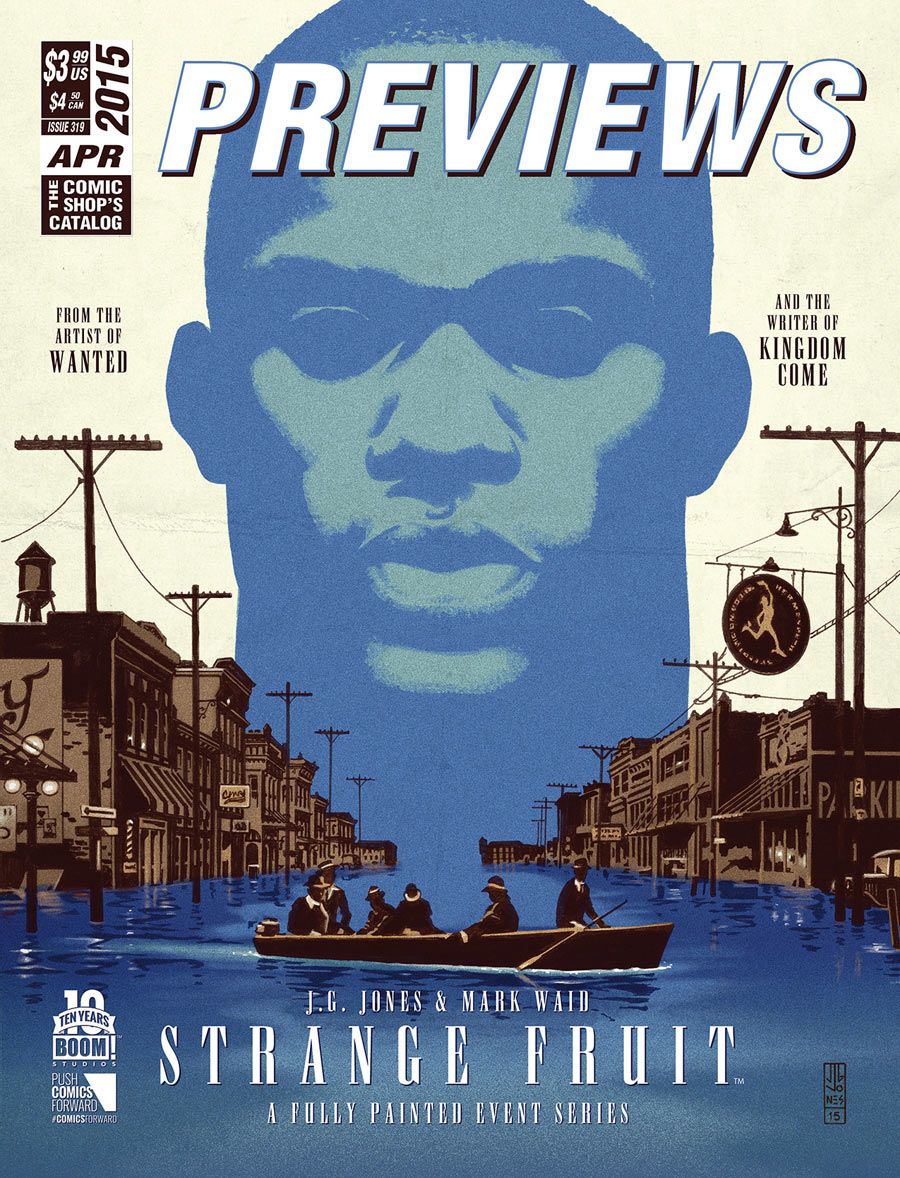Co-written by J.G. Jones and Mark Waid, with fully painted artwork by Jones, BOOM! Studios' recently announced "Strange Fruit" takes place in Chatterlee, Mississippi, in 1927. Not only is this a town brimming with racial tension, it's also pressed on all sides by The Great Mississippi Flood, which threatens to literally wipe them off the map. And if all that wasn't enough, a man from the stars -- The Colossus -- lands in the middle of everything, with his own mysterious agenda.
Jones, acclaimed for his work with Mark Millar on "Wanted," with Grant Morrison on "Final Crisis," and more covers than we can count, announced plans to work with BOOM! in July on a project he would not only provide art for, but also co-write. The artist came up with the overall concept of "Strange Fruit," and began to plan it out, then asked his longtime friend Waid to join him in making the concept a full-fledged comic book reality.
EXCLUSIVE: First Details, Art From Jones & Waid's "Strange Fruit"
In an exclusive first conversation about the four-issue series, Jones and Waid open up about their shared creative process, discussing how they're developing a story combining historical reality with alien lifeforms, the complicated task of dealing with complex issues of racism and equality in their combined work, and why a series as challenging as this is exactly the right one for Jones to launch his writing career with.
CBR News: J.G., I understand you initially came up with "Strange Fruit" on your own. How long had you been working on this before you contacted Mark?
J.G. Jones: I have had the idea for a much larger story kicking around in my head for years. I originally approached BOOM! with a story I wanted to write -- something completely unrelated -- but I didn't want to draw that project, as I saw it as better suited to a different sort of art than what I do. Of course, BOOM! wanted something that I would be doing art on as well, so I dusted off the bigger concept I had been kicking around, and pinched off apiece of the dough to form what became the "Strange Fruit" tale.
Mark and I had talked about this idea a while back, and I knewin addition to responding strongly to the idea,he had some previous affiliation with BOOM!, so I pitched the idea of him writing it with me. We are both from the deep South, and growing up there left a strongimpression on the both of us.
Following the announcement of the book, there was some response on social media expressing skepticism towards two white creators telling a story about the historical Black experience. How would you respond to that notion?
Mark Waid: That it's a fair point and a responsibility that we do not take moderately or without careful consideration and some measure of peer review. We'll have more to say about this as the release date nears, I'm sure -- although, ultimately, the story itself will have to stand or fall on its own, and we are not being the least bit flippant when we say that, we're grateful to those who have chosen to give us the benefit of the doubt for now.
The title itself, "Strange Fruit," holds a lot of weight considering lyrics of the Billie Holiday song of the same name.
Jones: Yeah, that Billie Holiday song sends shivers up my back whenever I hear it. Obviously, we wanted to evoke the Jim Crow South, the dangers and divisions. The song speaks directly to man's inhumanitytoward man. Stan Lee talked about the X-Men stories as a way to talk about race, bigotry and fear. I always wanted to take a more direct approach.
A story's setting can often become a kind of character in a story like this. How would you characterize Chatterlee, Mississippi?
Jones: The story is not only tied to a specific time and place, but to a specific event: the Great Mississippi Flood of 1927. TheMississippi River flooded along its entire length that year, topping levees all throughthe Delta, destroying lives andlivelihoods. There had been a great ongoing debate between engineers who wanted to have natural outlets, like the Atchafalaya Basin, to take the extra water and relieve the pressure on the river, and those who thought that you should close off all outlets and build high levees to allow the river to scour its own channel deeper as it flooded to the Gulf of Mexico. 1927 was a real-time test of that theory, and the results were pretty stark for millions of people.
Waid: It's a town where fear has been ratcheted up a thousandfold. The rain never stops. Stories pour in constantly from up north about another town lost to the flood, another levee shattered. The men and women of Chatterlee are living in the shadow of almost-certain death, and that has emotions -- and tensions -- running high.
Moving on to the actual characters, who does "Strange Fruit" focus on in that regard?
Jones: I'll defer to Mark here, but I will just say that one thing we talked about constantly was not having one-dimensional characters.
Waid: Amen. That's what we've been concentrating the hardest on -- not the plot, not the look, not the tone, but the characters. If any of them are one-dimensional, we've failed. If we make any of them "evil," we've failed. If we make any of them flawless, we've failed. You don't need to pay us for a story about stereotypes. Saints and arch-villains are the stuff of fairytales, and there was nothing about rural Mississippi life in that time that could honestly be defined as such.
In addition to the flood, the story deals with a fiery being called The Colossus coming down from the skies. What does his presence mean for the people of Chatterlee?
Jones: Each character has a reason for why they are invested in their actions. The appearance of The Colossusacts asa mirror on their motives.
Waid: Exactly. Some see him as a threat, some see him as a savior, but there's every chance he's neither. He's not Superman. He has his own motives and his own goals, and the suspense comes from not knowing how these may align with anyone in Chatterlee, regardless of their ethnicity.
The two of you were both part of DC Comics' creative team for "52." Did that familiarity, that shared past, help when coming together for "Strange Fruit?"
Jones: Mark and I have known one another almost since I first got into comics. We were both living in Brooklyn at the time, and I think we just hit it off. Maybe it was his collection of Major Matt Mason toys from the '60s, a particular obsession of my childhood. I have been very fortunate to have worked with some of the best writers in the business over the years, but Mark was my white whale -- one of my favorite writers I never got to work with. I guess we technically did work on the same project with "52," but I was just the cover guy, and it wasn't as though we were creating a story together.
Waid: One of the best parts of brainstorming on "52," though, was that J.G. was in the room with the writers when we had our story conferences. It was so apparent that he was able to get excited by that energy and be a true collaborative force that if I'd ever had any doubts that he'd be fun to work with, those were permanently put to rest.
What was the process like, hammering out the series once Mark came on board?
Jones: We do a lot of the work over the phone and by e-mail. It's been a lot of fun. We had a lot of long discussions about the story, and shared a lot of research and reading to get the time and place right, not to mention trying to keeping a flavor of historical accuracy. I read a lot of historyin my spare time, and most of my ideas for stories come from that. We couldn't just assume that because we grew up down around the Delta, we understood exactly what was going on in the '20s.
Waid: There's a lot of back-and-forth, which is great. Even once I sat down, based on all our notes and conversations, to write a full script, it was with the understanding that it was a work-in-progress -- as J.G. worked on the pages, new ideas would come to us both, and we'd fold those in.
Did that partially shared history, with both of you being from the South, help with the creative process?
Jones: I think it definitely helped. We are the same age, and grew up in a really fraught atmosphere, where things were finally beginning to change, though everything had to be fought over, and is still not settled. But I think we both understand the good and the badof that upbringing. I grew up in a small town, and as a kid, we ran around barefoot, went hunting and fishing with my grandfather, and drove anything that had a motor because my dad loved cars and motorcycles. We had an actual ice cream shop and general store, dogs and cats and cows, and sometimes chased down this really evil pony that we tried to ride. It was anidyllicplace to grow up.
But not for everyone, obviously. Plentyof injusticegoing around. There was also a lot of poverty, anger and resentment.
Do you think having grown up in the South gives you both a little more insight into the racial tension at the center of "Strange Fruit?"
Jones: I don't want to speak for Mark, but for me, these issues have always been fraught. InSundayschool, they taught us a song: "Red and yellow, black and white, they areprecious in His sight." But when the song was done, that sentiment seemed to evaporate pretty quickly. Look, treating a group of people as the "other" does not just dehumanize that group, it also dehumanizes you.
Waid: I think more than anything, it's informed our mutual understanding of how casual and commonplace racism was when we were kids, which, looking back, is shocking, but living through that time,it was -- however inexcusable in hindsight -- an everyday part of the fabric of the South.
That said, neither J.G. nor I are claiming to ever really know -- reallyknow -- what it's like to endure that level of racism. The racial tension in "Strange Fruit" is a huge part of this story, but as two white guys, we're not in the least interested in co-opting the story of an ethnicity not our own. What we are trying to do is be as historically accurate as possible, and that means some rough language and rough imagery.
J.G., what led you to paint this book instead of going the more traditional penciling route for interiors?
Jones: It's funny, I talked about how BOOM! just wanted a small project with my artwork to sort of announce to the world that I was creating stories of my own. I don't think they were expecting me to jump into the deep end of the pool so quickly, but the more we worked on the story, the more I felt I was getting immersed in the tale, and then I decided to bring everything I had to the project. I had been painting covers for years, but I never dove in and tried painting an entire book. It's an immense amount of work! I don't really have much in the way of free time these days.
I think the painting gives it a more immersive quality. I'm not trying to make it photorealistic, but there is an immediacy to the painted pages that is sometimes absent in the layers, qualityachieved by pencils, inks and digital color. I love black and white, too, and I love working in all mediums, but I wanted to see if this was something I could pull off.
What made BOOM! the right place to publish "Strange Fruit?"
Jones: Because they were not onlywillingto publish it, but were eager to publish the book. I had pitched a few similar projects elsewhere, but I just couldn't find the right fit. Assoon as I pitched the concept, with Mark attached, they were all in.
For both of you, how important is it to have work like this, that's your own and more personal than perhaps work for hire projects?
Jones: Well, Mark has had the great fortune of doing a lot of amazing work with characters of his own creation. For me, this is a big deal. I have always written my own stories, and have several graphic novels typed up that I never had the time to draw because I have been so busy with earning my keep on established characters. I'm like the dog they take out to the park and take the leash off for the first time. I took off running, and now I'm looking around and wondering, "How the hell did I get out here?" The freedom is kind of strange andexhilarating.
So why do this story? Why not do something easier and more comfortable? Because this is a passion project for me. It's a chance to use fiction to take a look at some hard truths -- things that I have been chewing on since I was a youngster, and that we have not finished working through yet in this country.
Waid: It's the only way you grow as an artist. I love working on DC and Marvel and Archie characters, absolutely love it -- but working in a corporate universe, there are muscles you just can't stretch. When you're working on, say, Daredevil or Spider-Man, sometimes you tend to lose sight of the question, "What makes this a story Iwantto tell?" Taking on a project like "Strange Fruit" as a writer -- something so tonally and structurally unlike my superhero work -- forces me to throw out half the tools in my toolbox and find new ways of doing my job. That kind of world-building is an incomparable experience, and the opportunity on top of that to write a character piece with the power of history behind it, folding in the stories that my grandparents and my great-grandparents told me about the South back in the day, to hear and weigh those voices again as an adult -- that's what makes this one so personal.​
"Strange Fruit" #1, from J.G. Jones, Mark Waid and BOOM! Studios, hits stands in July, with an 11x17-inch narrative lithograph by Jones landing in June.

